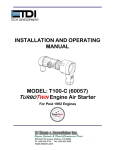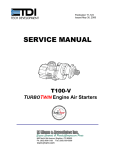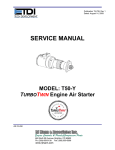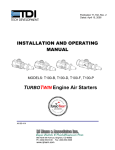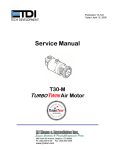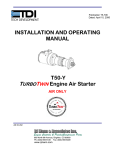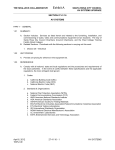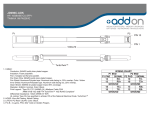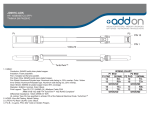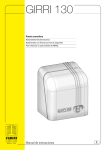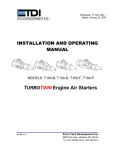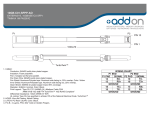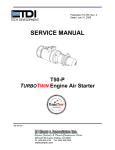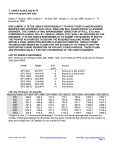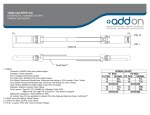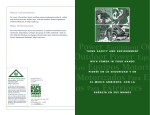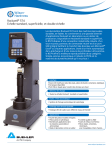Download T100 Series Service Manual - RJ Mann & Associates, Inc
Transcript
Publication T1-701, Rev. 1 Dated: April 15, 2006 SERVICE MANUAL T100 Series (T112B/T121B, T112D/T121D, T106F/T112F, T109P/T115P) TURBOTWIN ENGINE AIR STARTERS TDI TURBOTWIN™ FROM TECH DEVELOPMENT TABLE OF CONTENTS Section 1.0 2.0 3.0 4.0 5.0 6.0 7.0 Subject Introduction……………………………. Description of Basic Groups…………. Disassembly………………………… … Cleaning and Inspection…………… … Assembly………………………………. Parts List……………………………. … Accessories……………………………. LIST OF ILLUSTRATIONS Page Figure 1 4 8 12 15 21 30 23 24 25 26 27 28 29 30 31 32 33 LIST OF TABLES Table No. 1 2 3 4 5 Title T100 Series Service Tool Kits……….. Cleaning Materials & Compounds.. … Parts Inspection Check Req………. … Parts Wear Limits………………….. … Materials for Assembly……………….. Page Title Page Pressing Bearing onto Shaft………….. 18 Installing Shaft into Gearbox Hsg…….. 18 Tightening Retainer Nut……………….. 19 Woodruff Key Installation……………… 19 Tightening Retainer Nut (T106F)…….. 20 Drive Hsg. Installation (T106F)………. 20 Illustrated Parts Breakdown (B)……… 25 Illustrated Parts Breakdown (P)……… 26 Illustrated Parts Breakdown (D)……… 27 Illustrated Parts Breakdown (D)……… 28 Illustrated Parts Breakdown (F)……… 29 8 12 13 14 15 LIST OF ILLUSTRATIONS Figure 1 2 3 4 5 6 7 8 9 10 11 12 13 14 15 16 17 18 19 20 21 22 Title Page TDI Turbotwin Nameplate……………. 2 T30 Series Part Number Coding…….. 3 Turbine Housing Assembly…………… 4 Gearbox Housing Assembly (B/P)…… 5 Gearbox Housing Assembly (F)……… 5 Gearbox Housing Assembly (D/Std)… 6 Gearbox Housing Assembly (D/Lg). … 6 Bendix Drive Assembly………………. 7 Bendix Drive Removal………………… 8 Bendix Drive Removal (F)……………. 9 Gearbox Retainer Nut Removal……… 9 Pressing Out Carrier Shaft……………. 10 Turbine Rotor Removal………………... 10 Turbine Shaft Removal….…………….. 11 Nozzle 2 Removal……………………… 11 Gear Teeth Wear Allowance………….. 14 Pressing Front Turbine Bearing………. 15 Pressing Spacer onto Bearing…………15 Installation of Turbine Shaft……………16 Installing the Aft Seal into Nozzle 1…...16 Pressing Aft Bearing onto Shaft……… 17 Planet Gear Carrier Shaft Assembly…. 17 Publication T1-701, Rev. 1 Issued April 15, 2006 Page: i TDI TURBOTWIN™ FROM TECH DEVELOPMENT SECTION 1.0 INTRODUCTION 1.1 GENERAL INFORMATION This manual provides information for servicing, disassembly, and reassembly of the TDI Turbotwin T100 series air starters. If there are questions not answered by this manual, please contact your local TDI distributor or dealer for assistance. Illustrations and exploded views are provided to aid in disassembly and reassembly. The TDI Turbotwin T100 series of engine starters are specially designed for starting today’s automated, lowemission engines. The Turbotwin uses aerodynamic speed control, eliminating the need for a mechanical automatic trip valve (ATV) to control starter motor speed. The Turbotwin T100 series air starters are suited to operate within a wide range of inlet pressures and ambient temperatures. These starters are designed for operation with either compressed air or natural gas. The robust turbine motor design in the Turbotwin T100 series starters has no rubbing parts, and is therefore tolerant of hard and liquid contamination in the supply gas with almost no adverse affects. The motor is well adapted to running on “sour” natural gas. As with all TDI air starter products, there are no rubbing parts so there is no lubrication required. This eliminates failures due to lubricator problems, the expense of installing and maintaining the system, and the messy and hazardous oil film around the starter exhaust. The starter is factory grease packed for the life of the starter so it requires no maintenance. NOTE Throughout this manual, the term “air” is used to donate the starter drive medium. Unless otherwise stated, “air” means compressed air or natural gas. Please review the rest of this manual before attempting to provide service to the TDI Turbotwin T100 series starters. 1.2 WARNINGS, CAUTIONS, & NOTES Throughout this manual, certain types of information will be highlighted for your attention: WARNING - used where injury to personnel or damage to equipment is likely. Publication T1-701, Rev. 1 Issued April 15, 2006 CAUTION - used where there is the possibility of damage to equipment. NOTE - use to point out special interest information. 1.3 DESCRIPTION OF OPERATION The Turbotwin T100 series starters are powered by a pair of axial flow turbines coupled to a simple planetary gear reduction set. The T100 series starters incorporate an inertia bendix drive coupled to the starter gearbox drive train to provide a means of disengaging the pinion from the engine’s ring gear. The high horsepower of the turbine air motor combined with the planetary gear speed reducer results in a very efficient and compact unit. The Turbotwin T100 series starters can be used over a wide range of drive pressures from 30 psig (2 BAR) to 150 psig (10 BAR) and are suitable for operation on either air or natural gas. The Turbotwin T106F & T112F weighs approximately 47 pounds (21 KG) and each is capable of delivering over 44 HP (33 kW) of cranking power at their maximum pressure of either 150 psig (10 BAR) or 90 psig (6 BAR) respectively. The Turbotwin T112B & T121B weighs approximately 55 pounds (25 KG) and each is capable of delivering over 80 HP (60 kW) of cranking power at their maximum pressure of either 150 psig (10 BAR) or 90 psig (6 BAR) respectively. The Turbotwin T112D &T121D weighs approximately 70 pounds (32 KG) and each is capable of delivering over 80 HP (60 kW) of cranking power at their maximum pressure of either 150 psig (10 BAR) or 90 psig (6 BAR) respectively. The Turbotwin T109P & T115P weighs approximately 59 pounds (27 KG) and is capable of delivering over 60 HP (41 kW) of cranking power at their maximum pressure of either 150 psig (10 BAR) or 90 psig (6 BAR) respectively. 1.4 INSTALLATION AND SERVICE It is important to properly install and operate the TDI Turbotwin T100 series starters to receive the full benefits of the turbine drive advantages. It must be installed in accordance with the instructions provided by Tech Development, Inc. (TDI). Page 1 TDI TURBOTWIN™ FROM TECH DEVELOPMENT WARNING Failure to properly install the starter or failure to operate it according to instructions provided byTDI may result in damage to the starter or engine, or cause personal injury. DO NOT OPERATE THIS STARTER UNLESS IT IS PROPERLY ATTACHED TO AN ENGINE. Repair technicians or service organizations without turbine starter experience should not attempt to repair this starter until they receive factory approved training from TDI, or its representatives. Proper operation and repair of your TDI Turbotwin will assure continuous reliability and superior performance for many years. NOTE You should always have the starter’s Part Number, Serial Number, Operating Pressure, and Direction of Rotation information before calling your TDI distributor or dealer. TDI TURBOSTART™ ENGINE AIR STARTERS FROM TECH DEVELOPMENT, INC. BARBER-COLEMAN - a Siebe Company 6800 POE AVE., DAYTON, OH 45414 MODEL NO. SERIAL NO. T112-B 1.5 NAMEPLATE INFORMATION The nameplate, located on the turbine housing, provides important information regarding the construction of your T100 series starters, refer to Figure 1. The part number coding explanation, refer to Figure 2, can help you when talking to your distributor. 9609-124 PART NUMBER T112-60001-B1R CW (RH) X CCW (LH) AIR or NAT. GAS USAGE MAX PRESS. 150 PSIG MAESURED AT INLET WHILE OPERATING PROOF PRESSURE OF HOUSING IS 600 PSIG WARNING:DO NOT OPERATE UNLOADED OR WITHOUT TURBINE GUARD OR EXHAUST FITTING U.S PATENT 4509896 Figure 1. TDI Turbotwin Nameplate Page 2 Publication T1-701, Rev. 1 Issued April 15, 2006 TDI TURBOTWIN™ FROM TECH DEVELOPMENT Figure 2. Part Number Coding Publication T1-701, Rev. 1 Issued April 15, 2006 Page 3 TDI TURBOTWIN™ FROM TECH DEVELOPMENT SECTION 2.0 DESCRIPTION OF BASIC GROUPS 2.1 GENERAL The TDI Turbotwin T100 Series air starters are lightweight, compact units driven by a dual stage turbine type air motor. The starter is composed of three basic assembly groups: Turbine Housing Assembly; Gearbox Housing Assembly; and Bendix Drive Assembly. 2.2 TURBINE HOUSING ASSEMBLY The Turbine housing assembly, refer to figure 3, consists of a stage one (15) and a stage two (6) turbine wheel mounted on sungear shaft (33) . The front bearing (10) is secured by a retainer plate (32). The aft bearing is preloaded by wavy spring (12). The ring gear (29) is heat shrunk into the front of the turbine housing (26) and secured by a setscrew (25). Figure 3. Turbine Housing Assembly Page 4 Publication T1-701, Rev. 1 Issued April 15, 2006 TDI TURBOTWIN™ FROM TECH DEVELOPMENT 2.3 GEARBOX HOUSING ASSEMBLY The gearbox housing assembly, refer to figures 4, consist of a planet gear carrier and output shaft (35), three planet gears (37), needle bearings (38), spacers (36), and bearing pins (39). The carrier shaft is mounted on two ball bearings (41) in the gearbox housing (58). The retainer nut (48) secures the carrier shaft in the gearbox housing. The front bearing (41) is secured by a retainer plate (46). The back bearing is preloaded by use of a spring washer (42). Figure 4. Gearbox Housing Assembly (T112B/T121B/T109P/T115P) Figure 5. Gearbox/Bendix Assembly (T106F/T112F) Publication T1-701, Rev. 1 Issued April 15, 2006 Page 5 TDI TURBOTWIN™ FROM TECH DEVELOPMENT Figure 6. Gearbox Assembly (T112D/T121D STD MESH) Figure 7. Gearbox Assembly (T112D/T121D LONG MESH) Page 6 Publication T1-701, Rev. 1 Issued April 15, 2006 TDI TURBOTWIN™ FROM TECH DEVELOPMENT 2.4 BENDIX DRIVE ASSEMBLY The Bendix drive assembly, refer to figure 8, consists of an inertial engagement drive or “bendix” (57) and drive housing (61). The bendix is mounted to the output shaft with two keys and a retaining set screw (53). The other end of the drive unit is mounted into a needle bearing (54), which is installed in the nose of the drive housing. Figure 8. Bendix Drive Assembly (T112B, T121B, T112D, T121D, T109P, T115P) Publication T1-701, Rev. 1 Issued April 15, 2006 Page 7 TDI TURBOTWIN™ FROM TECH DEVELOPMENT SECTION 3.0 DISASSEMBLY 3.1 GENERAL Always mark adjacent parts on the starter housing; Nozzle 2/ Containment Ring (13), Turbine Housing (26), Gearbox Housing (58), and Bendix Drive Housing (61) so these parts can be located in the same relative position when the starter is reassembled. Do not disassemble the starter any further than necessary to replace a worn or damaged part Always have a complete set of seals and o-rings on hand before starting any overall of a Turbotwin T100 series starter. Never use old seals or o-rings. shaft. Remove the needle bearing (62), if necessary, by simply tapping out the “welch” plug from the front of the drive housing and press bearing out. 3.3 DRIVE HOUSING (T112D/T121D) 3.3.1 Removal of Drive Housing Remove the six screws (22). Mark position of bendix pinion opening relative to gearbox housing for reference during reassembly. Pull drive housing (49) from gearbox housing (44). If drive housing is too tight, tap it with a mallet to loosen. 3.3.2 Removal of Bendix Drive The tools listed in Table 1 are suggested for use by technicians servicing the Turbotwin T100 series starters. The best results can be expected when these tools are used, however the use of other tools are acceptable. TOOL DESCRIPTION TDI/PN Spanner wrench 52-20134 Spanner wrench 52-21345 Shaft Removal Tool 2-26945 Stage 2 Rotor Puller Tool 52-20076 Carrier Shaft Holding Tool 52-20202 Tool, Bearing Pressing 52-20143 Tool, Bearing/Seal 2-26943 Table 1. T100 Series Service Tools In loaded spring area of drive (57) remove retaining ring (51) from set screw (53) slot. Remove set screw using a flat head screwdriver, Figure 9, and pull the bendix assembly from the starter carrier shaft. Remove spring (52). This spring fits loosely between the bendix assembly and carrier shaft. Remove the needle bearing (62), if necessary, by simply tapping out the “welch” plug from the front of the drive housing and press bearing out. 3.2 DRIVE HOUSING (T112B,T121B,T109P,T115P) 3.2.1 Removal of Drive Housing Mark position of bendix pinion opening relative to gearbox housing for reference during reassembly. Remove the six bolts (60) and lock nuts (59). Pull drive housing (61) from gearbox housing (58). If drive housing is too tight, tap it with a mallet to loosen. 3.2.2 Removal of Bendix Drive In loaded spring area of drive (57) remove retaining ring (51) from set screw (53) slot. Remove set screw using a flat head screwdriver, Figure 9 and pull the bendix assembly from the starter carrier shaft. Remove spring (52). This spring fits loosely between the bendix assembly and carrier Page 8 Figure 9. Bendix Drive Removal Publication T1-701, Rev. 1 Issued April 15, 2006 TDI TURBOTWIN™ FROM TECH DEVELOPMENT 3.4 DRIVE/GEARBOX HOUSING (T106F/T112F) 3.4.1 Removal of Drive Housing Mark position of bendix pinion opening relative to turbine housing (26) for reference during reassembly. Per Figure 10, remove the six screws (27). Pull drive housing (69) from turbine housing. If drive housing is too tight, tap it with a mallet to loosen. Remove bearing (65) from shaft by pressing shaft while supporting inner race of bearing. Remove bearing retainer plate (64). 3.4.3 Planet Gear Disassembly Remove snap ring (34) from planet shaft (39) using snap ring pliers and push shaft through holes in assembly. Slide the planet gear (37) out from the carrier shaft and remove the two nylon spacer (36). Unless the needle roller bearings 38) are damaged, do not remove. If removal is necessary, simply press bearing out. Figure 10. Bendix Drive Removal (T106F/T112F) 3.4.2 Removal of Bendix Drive Remove four screws (31). Pull carrier shaft assembly (63) from drive housing (69). The bendix (68) will remain in the drive housing. With snap ring tool, remove snap ring (66) and bendix drive (68)from drive housing. Figure 11. Gearbox Retainer Nut Removal 3.5 GEARBOX HOUSING (T112B/T121B,T112D/T121D,T109P/T115P) * The drive housing removal procedure should be performed before performing this procedure. If it is necessary to remove needle bearing (70) from drive housing, simply press bearing out. 3.5.1 Removal of Gearbox Housing Mount the carrier shaft assembly on the TDI holding tool P/N 52-20202 placing the three holes on the gearbox over the dow pins. Refer to Figure11. Remove the six screws (27) and lift the gearbox assembly from the turbine assembly. If the gearbox assembly is too tight, tap it with a mallet to loosen). Place TDI tool P/N 52-21345 (Spanner Wrench) over shaft and into slots of retainer nut (67). Hold down carrier shaft and remove nut. 3.5.2 Gearbox Disassembly Publication T1-701, Rev. 1 Issued April 15, 2006 Mount the gearbox on the TDI holding tool P/N 5220202 placing the three holes on the gearbox over the dow pins. Refer to Figure 11. Page 9 TDI TURBOTWIN™ FROM TECH DEVELOPMENT Remove woodruff keys (40) from shaft by tapping them with a chisel and hammer With screwdriver remove tang of lockwasher (47) from slot of retainer nut (48). Place TDI tool P/N 52-20134 (Spanner Wrench) over shaft and into slots of retainer nut. Hold gearbox down and remove nut. In most cases the gearbox housing (58, D-44) can be removed from the carrier shaft (35) by holding shaft down and pulling directly up on housing. If this is not the case, press carrier shaft from housing per Figure 12. Slide the planet gear (37) out from the carrier shaft and remove the two nylon spacer (36). Unless the needle roller bearings 38) are damaged, do not remove. If removal is necessary, simply press bearing out. 3.6 TURBINE HOUSING 3.6.1 Stage 2 Rotor Removal Remove the six screws (27) that connect the gearbox assembly to the turbine housing and separate the two assemblies. Remove the four screws (18) and the clamping plate (32). Turn the turbine to the (exhaust) end up and remove the six screws (1), screen support ring (2), and the screen (3). For the T109P, remove six screws (74) and Exhaust Cover Housing (75). Hold the stage 2 rotor (6) and remove the turbine screw (4) and washer (5). Install the rotor puller tool P/N 52-20076 and remove the stage 2 rotor per Figure 13. Remove the woodruff key (7) using a hammer and chisel. Figure 12. Pressing Out Carrier Shaft The aft bearing (41), spring washer (42), and bearing spacer (43) will come out with the shaft. Remove aft bearing (41) from shaft by pressing shaft while supporting bearing. If the aft bearing (41) is retained in the gearbox housing when the carrier shaft is removed, apply pressure through housing to the bearing to remove it. It will be necessary to elevate the housing with a brace to remove the bearing completely. Remove the six screws (18) and retainer plate (46). The front bearing may then be removed by lightly tapping. 3.5.3 Planet Gear Disassembly Remove snap ring (34) from planet shaft (39) and push shaft through holes in assembly. Page 10 Figure 13. Turbine Rotor Removal Publication T1-701, Rev. 1 Issued April 15, 2006 TDI TURBOTWIN™ FROM TECH DEVELOPMENT 3.6 Turbine Shaft Removal Using the shaft removal tool P/N 2-26945 per figure 14, press on the turbine shaft (33) while supporting the turbine housing. Press the shaft assembly (33) through the aft bearing (10) and continue pressing until the shaft assembly is completely out of the housing (26). Remove the woodruff key (16), seal spacer (8), bearing spacer (30), and bearing (10) from the shaft. The bearing can be removed from the shaft by pressing the shaft through the bearing. Note that if T100 is the original design (SN: 9501-239 to9611-191), the bearing will be pressed inside a spacer. Separate the stage 2 nozzle assembly (13) from the turbine assembly (26) by firmly holding the turbine assembly, while tapping nozzle 2 with a mallet. If nozzle 2 is too tight, it can be removed by installing two threaded screws into nozzle 2 and using them as jacks to separate nozzle 2 from the turbine assembly. Refer to Figure 15. Rotate the stage 1 rotor if necessary to allow the jacks to travel through the large holes in the rotor. The jacks will damage the stage 1 rotor if pressure is applied to them while removing nozzle 2. The stage 1 rotor (15) may now be removed. Remove the four screws (18) and nozzle 1 (19) from the turbine assembly. It may be necessary to tap the screws with a hammer and chisel to loosen. On the stage 2 nozzle (13), remove the seal spacer (8) from the forward side of the nozzle. Place the stage 2 nozzle on the exhaust end. Press through the lip seal onto the bearing until it, including the 2nd lip seal and seal spacer disengages from the nozzle. Turn the nozzle over and press on the lip seal to remove. Figure 14. Turbine Shaft Removal Figure 15. Nozzle 2 Removal Publication T1-701, Rev. 1 Issued April 15, 2006 Page 11 TDI TURBOTWIN™ FROM TECH DEVELOPMENT SECTION 4.0 CLEANING and INSPECTION Clean aluminum parts using the solutions per Table 2; soak for 5 minutes. Remove parts, rinse in hot water, and dry thoroughly. 4.1 CLEANING Clean corroded steel parts with a commercially approved stripper. Degrease all metal parts, except bearings, using a commercially approved solvent. Refer to Table 2. NOTE Never wash bendix assembly or bearings in cleaning solvents. It is recommended that the bearings be replaced with new parts. Clean corroded aluminum parts by cleaning as stated above and then immerse the parts in chromic-nitricphosphoric acid pickle solution per Table 2. Rinse in hot water and dry thoroughly. MATERIAL or COMPOUND Degreasing Solvent (Trichloroethylene) (O-T-634) Acetone Aluminum Cleaning Solution MANUFACTURER Commercially Available Commercially Available Diversey Corp., 212 W. Monroe, Chicago, IL 60606 Dissolve 5 oz of Diversey 808 per gallon of water at 155°- 165°F. Steel Cleaner - Rust & Corrosion Oakite Products Corp., 50 Valley Rd., Berkeley Heights, NJ 07992 Mix 3-5 lb. of Oakite rust Stripper per gallon of water; use at 160°- 180°F. Chromic-Nitric-Phosphoric Acid Pickle Solution Mix 8lb. of chromic acid, 1.9 gal. of phosphoric acid, 1.5 gal. of nitric acid with enough water to make a total of 10 gal. of solution. WARNING Follow all instructions provided with the MSDS sheets on the materials and compounds listed above. Table 2. Cleaning Materials and Compounds 4.2 INSPECTION Use Table 3 as a guide to check for acceptable condition of the parts listed. Check all threaded parts for galled, crossed stripped, or broken threads. Check all parts for cracks, corrosion, distortion, scoring, or general damage. Page 12 Check all bearing bores for wear and scoring. Bearing bores shall be free of scoring lines, not to exceed 0.005″ width and 0.005″ depth. Check gear teeth and turbine housing ring gear for wear. In general, visually check for spalling, fretting, surface flaking, chipping, splitting, and corrosion. If wear is apparent, check the gear teeth dimensions in accordance with Table 4. Nicks and dents that cannot be felt with a .020 inch radius scribe are acceptable. Publication T1-701, Rev. 1 Issued April 15, 2006 TDI TURBOTWIN™ FROM TECH DEVELOPMENT Part Description Bendix Drive Housing Planet Gear Check For Worn, loose, or missing parts Cracks and breakage Cracked, chipped, or galled teeth. Wear must not exceed limits per Table 4. Carrier Shaft Cracks, scoring or raised metal in planet shaft holes and keyways. Integrity of knurl connection. Planet Pins Wear grooves or flat spots Washers Gearbox Housing Sungear / Turbine Shaft Wear created grooves Cracks and Breakage Cracks, scoring, wear created grooves, chipped or broken gear- teeth, galling or scoring on bearing surface of shaft. Raised metal on the keyway. Parallelism of end surfaces Cracks and breakage Spacers Turbine Housing Ring Gear Seal Assembly Seal Spacer Needle Bearings Ball bearings Containment Ring/ Nozzle Turbine Rotors Cracks, wear, chipped, or broken gear teeth. Wear grooves or scratched surfaces on carbon ring. Wear Grooves Freedom of needle rollers Freedom of rotation without excessive play between races Corrosion, erosion, cracks and broken nozzle edges. Corrosion, erosion, and broken edges. cracks Requirements (Defective Parts Must Be Replaced) Defective unit to be replaced. Use figure 5 as a guideline for acceptable pinion wear. Cracks are not acceptable Wear must not exceed limits per table 4. There shall be no evidence of excessive wear. Deformation of metal smearing in planet pin holes & keyways not acceptable. Scoring on bearing diameter not to exceed .005″ depth. Wear must not exceed limits per Table 4. Wear grooves in flat spots not permitted. Wear must not exceed limits per Table 4. Wear must not exceed limits per Table 4. Cracks and breakage not acceptable. Wear must not exceed limits per Table 4. Ends must be parallel within 0.0005″. Cracks and breakage are not acceptable. Minor surface damage is permitted if function is not impaired. Wear must not exceed limits per Table 4. Wear is not permitted. No wear permitted. Replace bearings Replace bearings Cracks and breakage are not acceptable. Minor surface damage is permitted if function is not impaired. Minor tip rub is permitted if function is not impaired. Tip wear; bore and key way Wear is not permitted. wear Table 3. Parts Inspection Check Requirements Publication T1-701, Rev. 1 Issued April 15, 2006 Page 13 TDI TURBOTWIN™ FROM TECH DEVELOPMENT PART DESCRIPTION LIMIT, Inches Ring gear / Turbine Housing Internal measurement between two .084″ diameter 5.0890 max. pins. Sun Gear / Turbine Shaft 0.6690 min Bearing diameter External measurement over two .096 diameter pins. 7.5:1 0.952 min 9:1 0.808 min 11.4:1 0.670 min Planet Gear External measurement over two .0864″ diameter pins. 2.3067 min 7.5:1 2.3699 min 9:1 2.4359 min 11.4:1 Carrier Shaft 1.1800 min Bearing Diameter 0.8750 max Planet Pin Bore Planet Pins 0.873 min Bearing Diameter Thrust Washer .055 min Thickness Table 4. Parts Wear Limits Figure 16. Gear Teeth Wear Allowances Page 14 Publication T1-701, Rev. 1 Issued April 15, 2006 TDI TURBOTWIN™ FROM TECH DEVELOPMENT SECTION 5.0 ASSEMBLY 5.1 GENERAL The tools listed in Table 1 are suggested for use by technicians servicing the T100 Series starters. The best results can be expected when the proper tools are used, however, use of other tools is acceptable. CAUTION Replace all screws , O-rings, lip seals, and bearings when the T100 Series starter is reassembled. These parts are included in the overhaul kits shown in Section 6.0 NOTE Always press the inner race of a ball bearing when installing a bearing on a shaft. Always press the outer race of a ball bearing when installing into a housing. Figure 18. Pressing Spacer onto Bearing Refer to Section 6.0, for a list of kits and components, which are available to aid in rebuilding T100 Series starters. Lubricate all O-rings with petroleum jelly or Parker-ORing Lube before assembly. Refer to Table 5 for a list of materials to be use during assembly. MATERIALS SOURCE Petroleum Jelly Commercially Available Parker-O-Ring Lube Commercially Available Loctite RC290 Commercially Available Grease, gearbox TDI P/N 9-94121-001 Table 5. Materials for Assembly CAUTION The screws that secure the Containment Ring/ Stage 2 Nozzle must have a drop of Loctite RC290 applied to the threads before being used. 5.2 TURBINE HOUSING 5.2.1 Turbine Shaft Installation Press the bearing (10) onto the shaft (33) until seated. Support the shaft and press on the inner race only with press tool P/N 2-26943 per Figure 17. Note that if T100 is the original design (SN: 9501-239 to 9611191), press the spacer (31) onto the outer race of the bearing (10) per Figure 18 by supporting the bearing outer race, and then press the bearing/spacer (10, 31) onto the shaft. Press the bearing/shaft assembly, keyway end first, into bearing housing of the turbine housing. Use press tool P/N 2-26943 if required per Figure 19. Do not press on the end of the shaft because the load could damage the balls of the bearing. Figure 17. Pressing Front Turbine Bearing Publication T1-701, Rev. 1 Issued April 15, 2006 Page 15 TDI TURBOTWIN™ FROM TECH DEVELOPMENT Install bearing retainer plate (32) and secure with four screws (18). Torque screws to 30 in-lbs. Install nozzle 1 onto the turbine housing (26). Orient the nozzles facing the air inlet (23). Install four screws (18) to secure the nozzle. Do not tighten the screws at this time. 5.2.3 Rotor 1 Installation Install the woodruff key (large key) (16) for stage 1 rotor into the shaft (33). Install the stage 1 rotor (15), while supporting sun gear end of shaft, onto the turbine shaft by aligning the slot in the rotor with the woodruff key and hand press the rotor until firmly seated. Use press tool P/N 2-26943 if required. Visually inspect that the key was not pushed out during assembly. Note that the direction of rotation was oriented properly. This turbine rotor can be installed backwards. Figure 19. Installation of Turbine Shaft Temporarily install Nozzle 2 on the turbine housing. Tighten the four screws that secure nozzle 1 (18) to 30 in-lb. The four screws can be accessed via the holes in nozzle 2 and the first stage turbine rotor. Remove Nozzle 2 when the four screws are tight. Place turbine housing front surface (sungear end) on flat surface. Install long bearing space (30) over shaft. 5.2.3 Nozzle 2 Installation Install the seal spacer (8) onto the shaft. Note the small end of the spacer faces the long bearing spacer. Press the lip seal (9) into the forward side of nozzle 2 with seal lip facing up. Use press tool P/N 2-26943. Install the O-ring (21) into the aft face of the turbine housing (26). Install the O-ring (11) into the bearing bore of nozzle 2 (13). DO NOT LUBRICATE THIS O-RING. 5.2.2 Nozzle 1 Installation Install O-ring (14) onto the outer diameter of nozzle 2. Press the aft seal (17) into nozzle 1 (19) using press tool P/N 2-26943 per Figure 20 with the lips facing up. Install nozzle 2 (13) onto the turbine housing (26). The three flats of nozzle 2 are always oriented opposite the turbine housing air inlet (SN 9505-213 to 9611-191). Install the seal spacer (8) onto the shaft with the small end facing the aft bearing (10). Install the wavy spring washer (12) into the bearing bore of the stage 2 nozzle. Support the sun gear end of the shaft. Press the aft bearing (10) onto the shaft by pressing onto the inner and outer race simultaneously. Use press tool per Figure 21. Press until bearing is seated. Figure 20. Installing the aft seal into Nozzle 1 Page 16 Publication T1-701, Rev. 1 Issued April 15, 2006 TDI TURBOTWIN™ FROM TECH DEVELOPMENT 5.2.5 Air Inlet Installation Place (23). the O-ring (24) into the groove on the air inlet Install the 2″ NPT air inlet flange (23) and secure with six screws (22). Tighten the six screws to 170 in-lb. Mark the number of stage 1 nozzles (usually 6, 12,or 21) onto the O.D. of the unit for identification of the unit prior to name plate installation. 5.3 GEARBOX HOUSING (T112B/T121B, T112D/T121D, T109P/T115P) 5.3.1 Planetary Gear Carrier Reassembly If disassembled, press needle bearing (38) into planet gears (37). The planet gears are not identified by part number, therefore, dimensionally check if correct gears are being used. Use table 4 for over the wire measurements. With a thrust washer (36) on each side of gear, slide gear into carrier shaft slots (35), and align with pin holes. Figure 21. Pressing Aft Bearing onto Shaft Lightly slide plant shafts into aligned holes, making sure snap ring groove on end of pins goes in first per Figure 22. Install the seal spacer (8) with the small end facing the aft bearing (10). Press the lip seal (9) into the stage 2 nozzle using press tool P/N 2-26943 with lip seal facing up. Install the stage 2 woodruff key (7) into the shaft (33). 5.2.4 Stage 2 Rotor Installation Install the stage 2 rotor (6) onto the shaft. Use press tool P/N 2-26943 if required. Visually inspect that the key was not pushed out during assembly. Note that the direction of rotation was oriented properly. This turbine can be installed backwards. Install the rotor washer (5) and secure with screws (4). Tighten screw to 100 in-lb. Figure 22. Planet Gear Carrier Shaft Assembly Install the exhaust screen (3) and back plate (2). Secure with six screws (1). Tighten the screws to 80 inlb. NOTE Publication T1-701, Rev. 1 Issued April 15, 2006 Page 17 TDI TURBOTWIN™ FROM TECH DEVELOPMENT Make sure that anti-rotation pins on shafts are properly located in retaining slots of carrier shaft (35). Install snap ring (34) with a snap ring tool. 5.3.2 Gearbox Reassembly Press the bearing (41) into the forward side of the gearbox housing (58, D-44). Pressing force should be on the outer race only. Install retainer plate (46) and secure with six screws (18). Press rear bearing (41) onto carrier shaft (35) using TDI Tool P/N 52-20143 per Figure 23. Pressing force should be on the inner race of bearing. Install spring washer (42) and bearing spacer (43) onto shaft and locate against bearing. Figure 23. Pressing Rear Bearing onto Carrier Shaft Position carrier shaft assembly (35,41,42,43) into bearing bore of the gearbox housing (58). Lift up on housing and slide shaft down. If shaft will not slide into bearing bore, press housing per Figure 24 until bearing is seated (41). Place gearbox assembly on TDI Tool P/N 2-20202 per Figure 25. Install lockwasher (47) and then retainer nut (48). Torque to 600-800 in-lb. Tang lockwasher into retainer nut slot. Place O-ring (14) onto outer diameter of assembly. gearbox Thoroughly grease planet gears, ring gear and sun gear using the grease specified in Table 5 and pack the center of the gears with grease. 5.3.3 Gearbox to Turbine Housing Assembly Rotate carrier shaft (35) slightly, and at the same time, align gearbox into the front of turbine housing (26). Install six screws and torque 90-120 in-lbs. Figure 24. Installing Carrier Shaft into Gearbox Housing Page 18 Publication T1-701, Rev. 1 Issued April 15, 2006 TDI TURBOTWIN™ FROM TECH DEVELOPMENT 5.5. DRIVE/GEARBOX HOUSING (T106F/T112F) 5.5.1 Planetary Gear Carrier Reassembly If disassembled, press needle bearing (38) into planet gears (37). The planet gears are not identified by part number, therefore, dimensionally check if correct gears are being used. Use table 4 for over the wire measurements. With a thrust washer (36) on each side of gear, slide gear into carrier shaft slots (63), and align with pin holes. Lightly slide plant shafts (39) into aligned holes, making sure snap ring groove on end of pins goes in first. NOTE Make sure anti-rotation pins on shafts are properly located in the retaining slots of the carrier shafts (63). Figure 25. Tightening Retainer Nut 5.4 DRIVE HOUSING (T112B/T121B, T112D/T121D, T109P/T115P) 5.4.1 Install bearing retainer plate (64) over carrier shaft (63) Press bearing (65) onto shaft making sure pressing force is on inner race of bearing only. Bendix Drive Installation Install two woodruff keys (40). properly installed per Figure 26. 5.5.2 Planetary Carrier Bearing Installation Ensure keys are Position bendix assembly (57) on shaft with retainer set screw (53) removed. Install spring ( 52) between bendix cavity and end of output shaft. Slide bendix over shaft until set screw hole aligns with set screw hole in shaft. Place carrier shaft assembly onto TDI Tool P/N 5220202, see Figure 27. Thread retainer nut (67) onto shaft (63). Hold carrier assembly down and torque nut to 600-800 lb.-in. with spanner wrench, TDI Tool P/N 52-21345. Install set screw and tighten firmly. Slip retainer (51) ring into set screw slot. 5.4.2 Bendix Drive Housing Installation If disassembled, press needle bearing (62, P-80) into drive housing (61) until flush with bottom surface. Mount drive housing over bendix drive, and align holes for desired bendix opening orientation with starter inlet connection. Torque bolts and nuts to 90-120 in-lbs. Figure 26. Woodruff Key Installation Publication T1-701, Rev. 1 Issued April 15, 2006 Page 19 TDI TURBOTWIN™ FROM TECH DEVELOPMENT Figure 28. Gearbox/Drive Housing Installation (T106F/T112F) Figure 27. Tightening Retainer Nut (T106F, T112F) 5.5.3 Bendix Drive Installation Install bendix drive (68) into drive housing (69), aligning bendix shaft into front needle bearing (70). With snap ring tool, install snap ring (66)into drive housing (69). Align carrier shaft assembly (63) into bendix drive and push assembly until seated against snap ring (66) per Figure 28. Install six screws (27) and torque 90 to 120 lb.-in. Page 20 Publication T1-701, Rev. 1 Issued April 15, 2006 TDI TURBOTWIN™ FROM TECH DEVELOPMENT SECTION 6.0 PARTS LIST The components illustrated and/or described in this section are for the Turbotwin T100 series air starters. When rebuilding a T100 series starter, it is recommended to purchase, and completely install the appropriate service kit(s). Key No. Description Part Number 1 Screw (6) 11F- 25020-072 2 Screen Support Ring 2-20831 3 Screen 2-26148 4 Screw 19F- 25028-012 5 Washer 9-93047 6 Rotor 2 2-26604 7 Woodruff Key 9-90211-006 8 Seal Spacer (3) 9 B D F 9 9 9 9 9 9 9 9-93083-001 9 9 9 9 Seal, Lip (2) 2-26719 9 9 9 9 10 Bearing (2) 9-91224 9 9 9 9 11 O-ring (2) 9-90001-027 9 9 9 9 12 Wave Spring Washer 9-90439 9 9 9 9 13i Nozzle 2/Containment Ring R.H. 2-27333-00R 13ii Nozzle 2/Containment Ring L.H. 2-27333-00L 14 O-ring 9-90001-050 9 9 9 9 15 Rotor 1 2-26603 16 Woodruff Key 9-90211-009 17 Lip Seal 2-22376 9 9 9 9 18 Screw (14) 14F-19024-008 9 9 9 9 19i Nozzle 1, R.H. 21 Noz 2-26718-21R 19ii Nozzle 1, L.H. 21 Noz 2-26718-21L 19iii Nozzle 1, R.H. 12 Noz 2-26718-12R 19iv Nozzle 1, L.H. 12 Noz 2-26718-12L Publication T1-701, Rev. 1 Issued April 15, 2006 P Page 21 TDI TURBOTWIN™ FROM TECH DEVELOPMENT Page 22 Key Number Description Part Number B D F P 19v Nozzle 1, R.H. 6 Noz 2-26718-06R 19vi Nozzle 1, L.H. 6 Noz 2-26718-06L 20 Pipe Plug 9-93556-004 21 O-ring 9-90001-034 9 9 9 9 22 Screw (6) or (12 for T112D/T121D std) 14F-31218-016 9 9 9 9 23 Inlet Flange 1-18967 24 O-ring 9-90001-037 9 9 9 9 25 Set Screw (See Note 1) 52F-50013-016 26 Turbine Housing (See Note 1) 2-27045 27 Screw (6) 14F-25020-016 9 9 28 Pipe Plug 9-93501-004 29 Ring Gear (See Note 1) 1-18780 30 Bearing Spacer 9-93091-001 31 Screw (4) 14F-25020-008 32 Clamping Plate 2-26750 33 Turbine Shaft 2-26554 34 Retainer Ring (3) 9-92001-001 35 Planet Gear Carrier Shaft 2P-20156-006 36 Washer (6) 9-93004 37 Planet Gear (3) 1-19441 38 Needle Roller Bearing (3) 9-91004-001 39 Planet Shaft (3) 2P-20182 40 Woodruff Key (2) 9-90211-019 41 Bearing (2) 9-91351 9 9 9 9 9 9 9 Publication T1-701, Rev. 1 Issued April 15, 2006 TDI TURBOTWIN™ FROM TECH DEVELOPMENT Key Description Part Number 42 Wave Spring Washer 9-90402-025 43 Bearing Spacer 9-93007 44 Gearbox Housing 2-22226 45 Screw (6) 14F-25020-028 46 Retainer Plate 1-18817 47 Lockwasher 9-93061-007 48 Retainer Nut 9-92127-007 49 Drive Housing 2-22301 50i Inertia Drive Assembly, R.H. 2-22795 50ii Inertia Drive Assembly, L.H. 2-22796 51 Retaining Ring Included with item 50 or 57 52 Spring Included with item 50 or 57 53 Set Screw Included with item 50 or 57 54 Needle Bearing 9-91393 55 Adapter Plate 2-22794 56 Screw 14F-31218-020 57i Inertia Drive Assembly, R.H. 1-18828 57ii Inertia Drive Assembly, L.H. 1-19083 58 Gearbox Housing 1-18810 59 Lock Nut (6) 9-92107-015 9 60 Screw (6) 11F-31218-024 9 61 Drive Housing 1-18822 62 Needle Bearing 9-91005 63 Carrier Shaft 3P-20858-006 64 Retainer Plate 2-20855 65 Bearing 9-91356 Publication T1-701, Rev. 1 Issued April 15, 2006 B D F P 9 9 9 9 9 9 Page 23 TDI TURBOTWIN™ FROM TECH DEVELOPMENT Key Description Part Number 66 Snap Ring 9-92001-006 67 Lock Nut 9-92105-008 68i Inertia Drive Assembly, R.H. 2-22147 68ii Inertia Drive Assembly, L.H. 2-22148 69 Drive Housing 2-20826 70 Needle Bearing 9-91380 71 Washer, Flat 9-93018-011 72 Nut, Hex 9-92108-003 73 Cover, Plate 2-20192 74 Screw (6) 11F-25020-072 75 Housing, Exhaust Cover 2-27069 76 Spring, Compression 9-90408-016 77 Post 2-27223 78 Drive Housing 2-25617 79 Screw (12) 11F-31218-024 9 80 Needle Bearing 9-91423 9 Model B D F P Page 24 Overhaul Kit for S/N’s before: 9611-191 T10B-27618 T10D-27619 T10F-27617 T10P-27620 B D F P 9 9 Overhaul Kit for S/N’s after: 9611-192 T10B-27634 T10D-27635 T10F-27633 T10P-27636 Publication T1-701, Rev. 1 Issued April 15, 2006 TDI TURBOTWIN™ FROM TECH DEVELOPMENT Figure 29. Illustrated Parts Breakdown (T112B/T121B) Publication T1-701, Rev. 1 Issued April 15, 2006 Page 25 TDI TURBOTWIN™ FROM TECH DEVELOPMENT Figure 30. Illustrated Parts Breakdown (T109P/T115P) Page 26 Publication T1-701, Rev. 1 Issued April 15, 2006 TDI TURBOTWIN™ FROM TECH DEVELOPMENT Figure 31. Illustrated Parts Breakdown (T112D/T121D, Standard Mesh) Publication T1-701, Rev. 1 Issued April 15, 2006 Page 27 TDI TURBOTWIN™ FROM TECH DEVELOPMENT Figure 32. Illustrated Parts Breakdown (T112D/T121D, Long Mesh) Page 28 Publication T1-701, Rev. 1 Issued April 15, 2006 TDI TURBOTWIN™ FROM TECH DEVELOPMENT Figure 33. Illustrated Parts Breakdown (T106F/T112F) Publication T1-701, Rev. 1 Issued April 15, 2006 Page 29 TDI TURBOTWIN™ FROM TECH DEVELOPMENT SECTION 7.0 ACCESSORIES SIZE PART NUMBER RELAY VALVES 1½" STAINLESS STEEL (AMOT) 52-93505 2" STAINLESS STEEL (AMOT) 52-93505-100 1½" 316 SST MANUALLY OPERATED 2" 316 SST MANUALLY OPERATED 1¼" NPT; BUNA N 1½" NPT; BUNA N 1¼" NPT; VITON 1½" NPT; VITON 12VDC; 1¼"; BUNA N 12VDC; 1½"; BUNA N 52-93508-300 12VDC; 1¼"; VITON RLVA-25683-012-2 12VDC; 1½"; VITON 24VDC; 1¼"; BUNA N 24VDC; 1½"; BUNA N RLVA-25683-012-2-01 RLVA-25683-024-1 RLVA-25683-024-1-01 24VDC; 1¼"; VITON RLVA-25683-024-2 24VDC; 1½"; VITON 110VDC; 1½"; VITON 120VAC; 1½"; VITON RLVA-25683-024-2-01 RLVA-25683-110-2-01 RLVA-25683-120-2-01 SIZE GAUGES REAR CENTER MOUNT U-CLAMP REAR CENTER MOUNT BOTTOM MOUNT PART NUMBER 52-21982 52-21982-100 52-21982-200 52-93508-400 RLVA-25683-001-1 RLVA-25683-001-1-01 RLVA-25683-001-2 RLVA-25683-001-2-01 RLVA-25683-012-1 RLVA-25683-012-1-01 PRESSURE REGULATORS 2" GAS 300 52-93552 2" GAS 125 52-93553 1½" AIR; MAX 1200 SCFM 52-20724-100 2" AIR; MAX 1600 SCFM 52-20724-200 EXHAUST 3" ELBOW KIT ECP KIT MUFFLER KIT (21 NOZ) MUFFLER KIT (6/12 NOZ) 3" NPT ADAPTER KIT FEMALE 4" NPT ADAPTER KIT FEMALE 4" STRAIGHT PIPE KIT 3" ELBOW KIT EXHAUST ELBOW W/ 3" PIPE WELD FLANGE EXHAUST ELBOW W/OUT WELD FLANGE T100-27015 T100-27068 T100-27074 T100-27075 T100-27651 T100-27652 T100-27791 T100-27900 T100-28182-001 T100-28182-002 CONTROL & SOLENOID VALVES 1/8" NPT STR CONROL VALVE 52-93504 1/4", 24 VDC, CONDUIT 52-21981 1/4", 12 VDC, GROMMET 52-21981-002 1/4", 120 VAC, CONDUIT 52-93506-100 1/4", 120 VAC, GROMMET 52-93506-200 1/4", 24 VDC, CONDUIT 52-93506-300 1/4", 24 VDC, GROMMET 52-93506-400 1/4" 72 VDC 52-93506-500 Y-STRAINERS 1½" CARBON STEEL BODY, #40 52-93549-100 MESH, SST SCREEN 2" CARBON STEEL BODY, #40 52-93549-200 MESH, SST SCREEN 1½" CAST IRON BODY, #40 52-93550-100 MESH, SST SCREEN 2" CAST IRON BODY, #40 MESH, 52-93550-200 SST SCREEN Page 30 Publication T1-701, Rev. 1 Issued April 15, 2006
































